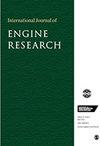重型柴油发动机连杆小端过盈装配的锡青铜衬套的松动机理
IF 2.1
4区 工程技术
Q2 ENGINEERING, MECHANICAL
引用次数: 0
摘要
常用的过盈装配旋转锡青铜衬套有时会出现故障,导致衬套旋转,甚至从连杆小端脱落。以往的研究表明,这种故障与小端温度异常有关。我们设计了与连杆小端相同材料和工艺的测试样品。测试了局部加热前后衬套内表面的残余应力和压紧力。结果表明,当衬套底部温度达到 160°C 时,内表面残余应力和最大压紧力随最高温度和热循环次数的增加而减小。应用连杆的四分之一模型揭示了松动机理。研究发现,油孔周围发生了塑性变形,导致衬套应力场发生变化。这降低了衬套与连杆小端之间的结合力。同时,内表面的残余应力减小,该区域的表面硬度随之降低,从而使其更容易与活塞销粘合并产生较大的摩擦力。这些结果对连杆小端衬套的材料和结构设计至关重要。本文章由计算机程序翻译,如有差异,请以英文原文为准。
The loosening mechanism of tin-bronze bushing assembled by interference at connecting rod small end of heavy-duty diesel engines
The commonly used spinning tin-bronze bushings assembled by interference sometimes fail causing the bushings to rotate or even come out from connecting rod small end. Previous studies have shown this failure to be related to the abnormal temperature of small end. Test samples with same material and process as the connecting rod small end were designed. The residual stress on inner surface and pressing force of bushings were tested before and after local heating. The results showed that the residual stresses on inner surface and maximum pressing force decrease with the increase of maximum temperature and thermal cycles when the temperature of bushing bottom reaches 160°C. A quarter model of connecting rod was applied to reveal the loosening mechanism. It is found that plastic deformation occurs around oil holes, resulting in variations in the stress field of bushing. It lessens the bonding force between bushing and connecting rod small end. Meanwhile, the residual stresses on inner surface decrease and then surface hardness of this area reduces, which makes it easier to adhere with piston pin and generate large friction. These results are crucial for the material and structure design of connecting rod small end bushings.
求助全文
通过发布文献求助,成功后即可免费获取论文全文。
去求助
来源期刊

International Journal of Engine Research
工程技术-工程:机械
CiteScore
6.50
自引率
16.00%
发文量
130
审稿时长
>12 weeks
期刊介绍:
The International Journal of Engine Research publishes high quality papers on experimental and analytical studies of engine technology.
 求助内容:
求助内容: 应助结果提醒方式:
应助结果提醒方式:


